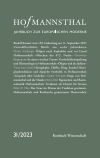Zusammenfassung
Das »Hofmannsthal – Jahrbuch zur europäischen Moderne« erscheint seit 1993 und gilt als das wichtigste Organ der Hofmannsthal-Forschung. Es stellt die Werke Hugo von Hofmannsthals (1874–1929) in den ästhetischen und sozialhistorischen Kontext der europäischen Kultur der Moderne und bietet neben der Veröffentlichung bisher unpublizierter Briefwechsel Beiträge namhafter Wissenschaftler:innen zur Literatur, bildenden Kunst, Philosophie, Psychologie, Politik, zu Tanz und Theater der Jahrhundertwende.Inhalt des diesjährigen Bandes:Rudolf Kassner zum 150. Geburtstag am 11. September 2023Unveröffentlichte Briefe aus sechs JahrzehntenMitgeteilt und kommentiert von Klaus E. BohnenkampMiriam Schabinger: Ödipus nach Sophokles und vor FreudHofmannsthals »Märchen der 672. Nacht«Maximilian Bergengruen: In einem »wachen Traum«Persönlichkeitsspaltung und Dämonologie in Hofmannsthals »Ödipus und die Sphinx«Traian-Ioan Geanӑ: Hieroglyphe, Chiffre, Ding, SymbolHieroglyphendiskurs und doppelte Symbolik in Hofmannsthals »Gespräch über Gedichte«Günter Schnitzler: Hugo von Hofmannsthal und die MusikAntonia Eder: Eigenzeiten und Raumsemantik Hofmannsthals Textkunst als Libretti für StraussPeter W. Marx: Das Neue im Prisma der Tradition gewinnen: Hofmannsthals und Reinhardts gemeinsame Theaterarbeit
Abstract
‘Hofmannsthal – Jahrbuch zur europäischen Moderne’ has been published since 1993 and is considered the most important organ of Hofmannsthal research. It places the works of Hugo von Hofmannsthal (1874–1929) in the aesthetic and socio-historical context of European modernist culture and, in addition to the publication of previously unpublished correspondence, offers contributions by renowned scholars on literature, the visual arts, philosophy, psychology, politics, dance and theatre at the turn of the century.Contents of this year's volume:Rudolf Kassner on his 150th birthday on 11th September 2023Unpublished letters from six decadesAnnotated and commented on by Klaus E. BohnenkampMiriam Schabinger: Oedipus after Sophocles and before Freud—Hofmannsthal's ‘Fairy Tale of the 672nd Night’Maximilian Bergengruen: In a ‘waking dream’—split personality and demonology in Hofmannsthal's ‘Oedipus and the Sphinx’Traian-Ioan Geanӑ: Hieroglyph, cipher, thing, symbol. Hieroglyphic discourse and double symbolism in Hofmannsthal's ‘Conversation on Poems’Günter Schnitzler:Hugo von Hofmannsthal and musicAntonia Eder: Eigenzeiten und Raumsemantik—Hofmannsthal's textual art as libretti for StraussPeter W. Marx: Gaining new ideas in the prism of tradition: Hofmannsthal and Reinhardt's joint theatre work

